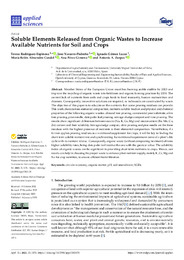Título :
Soluble Elements Released from Organic Wastes to Increase
Available Nutrients for Soil and Crops |
Autor :
Rodríguez Espinosa, Teresa 
Navarro-Pedreño, Jose 
Gómez Lucas, Ignacio
Almendro-Candel, María Belén
PÉREZ-GIMENO, ANA
Zorpas, Antonis  |
Editor :
MDPI |
Departamento:
Departamentos de la UMH::Agroquímica y Medio Ambiente |
Fecha de publicación:
2023-01 |
URI :
https://hdl.handle.net/11000/34749 |
Resumen :
Member States of the European Union must ban burning arable stubble by 2023 and
improve the recycling of organic waste into fertilizers and organic farming practices by 2030. The
current lack of nutrients from soils and crops leads to food insecurity, human malnutrition and
diseases. Consequently, innovative solutions are required, as technosols are constructed by waste.
The objective of this paper is to educate on the nutrients that some pruning residues can provide.
This work characterizes elemental composition, nutrients soluble fraction and physical and chemical
properties of the following organic wastes: almond tree pruning, commercial peat substrate, olive
tree pruning, pine needle, date palm leaf pruning, sewage sludge compost and vine pruning. The
results show significant differences between macro (Na, K, Ca, Mg) and micronutrient (Fe, Mn, Cu,
Zn) content and their solubility. Sewage sludge compost, olive pruning and pine needle are the three
residues with the highest presence of nutrients in their elemental composition. Nevertheless, if a
farmer applies pruning residues as a nutritional supplement for crops, it will be key to finding the
short-term soluble nutrient rate and synchronizing the nutritional requirement curve of a plant’s life
cycle with its nutrient release. Consequently, organic waste (without composting treatment) obtains
higher solubility rates, being date palm leaf residue the one with the greatest value. The solubility
index of organic wastes can be significant in providing short-term nutrients to crops. Hence, our
results can help in choosing the proper waste to enhance plant nutrient supply, mainly K, Ca, Mg and
Na for crop nutrition, to ensure efficient biofertilization
|
Palabras clave/Materias:
circular economy
organic matter
pH
soil amendment
SGDs |
Área de conocimiento :
CDU: Ciencias aplicadas: Ingeniería. Tecnología |
Tipo de documento :
info:eu-repo/semantics/article |
Derechos de acceso:
info:eu-repo/semantics/openAccess
Attribution-NonCommercial-NoDerivatives 4.0 Internacional |
DOI :
https://doi.org/ 10.3390/app13021151 |
Publicado en:
Applied Sciences, 2023, 13, 1151 |
Aparece en las colecciones:
Artículos Agroquímica y Medio Ambiente
|
 La licencia se describe como: Atribución-NonComercial-NoDerivada 4.0 Internacional.
La licencia se describe como: Atribución-NonComercial-NoDerivada 4.0 Internacional.
.png)
